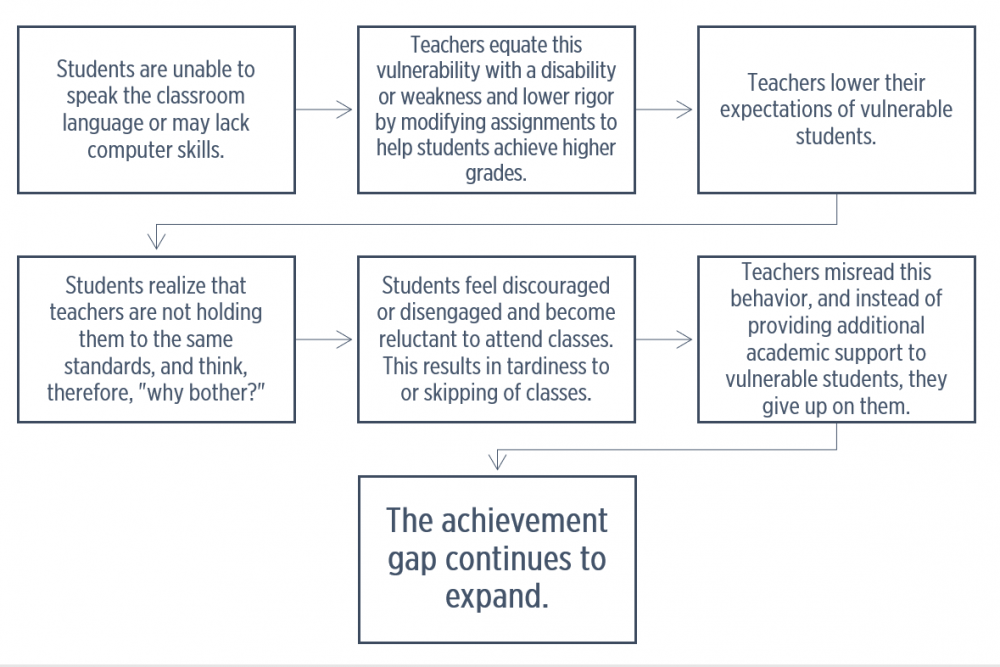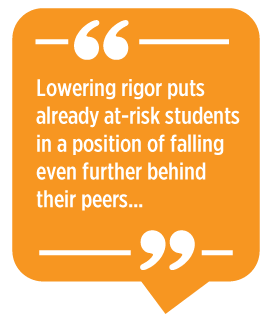|

The term vulnerable learner is
becoming more commonly used, but what does it mean? Who are these learners, and
why are they “vulnerable”? For the purpose of our work, we use the definition
developed by the Organisation for Economic Co-operation and Development (OECD),
which states that a vulnerable learner is any student with one or more of
the following identifiers: has a lower socioeconomic background, special needs, or a diverse gender, or is a language learner or minority (Reimers &
Schleicher, 2020).
Any one of these factors may impact a student’s
educational achievement because it acts as a barrier to their ability to focus
on educational learning without strong classroom and school support. Many
language learners within our schools have more than one factor that places them
at risk of failing academically, which has been exacerbated due to the COVID-19
pandemic. For vulnerable learners, the impact will be significantly more
devastating.
Issues Facing Vulnerable Learners
Multicultural students come into our classrooms
with diverse backgrounds that must be acknowledged by the teacher and school.
Although perhaps well-intentioned, misguided actions that minimize the cultural
and linguistic assets of multicultural students (e.g., giving every student an
“American name” or lumping all Spanish speakers together as “Hispanic”) result
in vulnerable learners not feeling like individuals, and not feeling socially
and emotionally supported.
There are several teacher actions that can lead to
undesirable student responses, and these can, in turn, lead to negative teacher
perceptions; it is an unfortunate cycle. Here are some examples of such
behavior and the damaging cycle that results in a spiraling toward a widening
achievement gap (see Figure 1):

Figure 1. Expansion of the achievement gap for
vulnerable students.
Click here to enlarge.
Lowering rigor puts already at-risk students in a
position of falling even further behind their peers without a clear path to how
that gap will be closed.
At a school wide level, vulnerable learners are
often educationally disengaged. They might question the value of going to
school, as many of them have experienced continued failure in multiple
settings. This disengagement is demonstrated in tardiness and inappropriate
behavior. Language learners and those with a disability may also struggle to
focus on multistep directions, questions, or activities. Rather than reveal a
lack of confidence or ability or show their sense of exclusion, many vulnerable
learners would prefer to misbehave and skip classes. Adults, then, perceive
that these students lack motivation, and therefore, do not want to learn.
However, by the secondary level, vulnerable
learners are not motivated to keep trying in a system designed to keep them
from succeeding.
These observable behaviors are universal across
school districts, states, and countries. The question that needs to be asked
is: How do we identify these behaviors for what they are and create an
environment where these learners can feel secure knowing that our schools will
help them? The changes that classrooms and schools may need to make are not
expensive and do not require the purchase of a new program. They just need the
dedication of teachers and administrators to create an equitable space for all
learners.
Strategies and Supports That Can Lead to Success
Creating an environment that is all-inclusive and
accepting of diversity will result in a welcoming space, which students can
easily recognize. This can happen concurrently with the school and community,
as well as the classroom.
In the School and
Community
Reengage School and Community. Creating an equitable space begins with the school and community.
Administrators can set the tone by helping their school and community reengage
with each other as well as taking the time to collaborate and engage with
teachers. According to Siler (2020), “The best solution is often found after
seeking information and engaging in dialog and thoughtful deliberation” (p.
108). These do not have to be in-depth sit-downs, but they can be conducted
through daily and/or weekly interactions making use of emails, short phone
calls, or quick drop-ins, both with teachers, parents, and the community.
Similarly, schoolwide initiatives that involve teachers, community, and parents
as valuable members of the learning team will also lead to increased dialog
between teachers and families. Families should be recognized and used as a part
of the team.
 Set a Tone of Rigor.
Administrators can also set the tone for how vulnerable learners are perceived
academically in their schools. Building and supporting a demand for a rigorous
curriculum goes a long way toward developing a school culture that emphasizes
that all students can learn. Teachers can feel that they are being supported to
push their students to their full potential and that their administrators will
support them with job-embedded professional development, resources, and
materials to reach all of their students. Set a Tone of Rigor.
Administrators can also set the tone for how vulnerable learners are perceived
academically in their schools. Building and supporting a demand for a rigorous
curriculum goes a long way toward developing a school culture that emphasizes
that all students can learn. Teachers can feel that they are being supported to
push their students to their full potential and that their administrators will
support them with job-embedded professional development, resources, and
materials to reach all of their students.
Provide Extended Learning
Opportunities. Purposefully scheduling extension and extended
learning opportunities for all students increases equitable learning. Adequate
time should be designed in the schedule for small-group instruction,
high-dosage tutoring, and 1:1 instruction, as needed. This can be done during
the school day as well as before and after, or even on the weekends.
Implement Restorative
Practices. Last, but not least, it would be remiss not to talk about
restorative practices (see www.iirp.org) and the need to take
a step back from traditional and punitive practices when dealing with student
discipline and infractions. “Restorative practices in schools create a healthy
atmosphere that supports positive development, teaching, and learning” (Brown,
2018, p. 7). Social and emotional support for the whole school are just as
important as academic needs.
In the Classroom
Create a Rigorous and Supportive
Classroom Environment. Invoking an equitable space for all students
in the school also demands that teachers design their classrooms with a similar
focus. A rigorous, grade-level curriculum needs to be the standard, along with
high expectations and academic support. Classrooms should be learner-focused
spaces where students can struggle and work with the curriculum as well as each
other, but also know that scaffolds and accommodations are in place as needed.
Students are the focus of the class, not teachers. The expectation should be
clear that students will articulate what they are learning with each
other.
Create a Safe and Trusting Classroom
Environment. Unquestionably, classrooms need to become places where
students can receive restorative strategies and support. It is key to teach
students the fundamentals of restorative practices so that when a conflict
occurs, all involved parties can move towards repairing relationships.
Restorative practices create spaces “…where students, teachers and staff want
to be; where they feel safe, trusted, and accepted; and where they experience
care and belonging” (Brown, 2018, p. 7). Challenges will occur, but our vulnerable learners need to learn how to reenter the
classroom after a conflict and move forward.
When teachers are enacting the aforementioned
strategies and supports, the classroom becomes a true place of learning for
all. Learners are taught to celebrate mistakes, assume the best, and applaud
their awesomeness (Boynton & Moore, 2021).
Conclusion
Students who are vulnerable learners are
increasingly falling behind in schools, but when school administrators,
teachers, and the community work together, these learners can achieve. Focus
needs to be placed upon academics as well as positive social-emotional
learning. It begins with administrators placing trust and support in their
teachers. When the staff begins to feel the positive efficacy from the
leadership team and know that they are valued members of the school, it can
trickle down to how they perceive the learners in their classroom. This, in
turn, will promote a positive classroom climate that promotes social as well as
academic success.
References
Boynton, M. J., & Moore, J. (2021, November
4–6). Creating equity for vulnerable learners [Conference
presentation]. Association for Middle Level Educators, Virtual.
Brown, M. A. (2018). Creating restorative
schools: Setting schools up to succeed. Living Justice Press.
Reimers, F., & Schleicher, A. (2020). Schooling disrupted, schooling rethought. OECD.
Siler, J. M. (2020). Thrive
through the five: Practice truths to powerfully lead through challenging
times. Dave Burgess Consulting.
Dr.
Jana Moore is a teacher on special
assignment and program lead at Parkside Middle School in Manassas, Virginia,
USA. Her foci include long-term English learners and vulnerable learners. In
her current capacity, Dr. Moore works as an instructional coach to provide
teachers with direction in creating equitable classrooms for these
learners.
Dr. Mary Jane
Boynton is principal of Parkside Middle
School in Manassas, Virginia, USA, in her 30th year in education and her 16th
year as an educational leader. Under her leadership, Parkside became a
Cambridge International School and Cambridge International Professional
Development Site. Dr. Boynton provides a wide variety of professional learning
opportunities to educators, with the focus on teaching and learning, bilingual
education, digital literacy, and educational leadership.
|